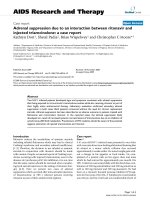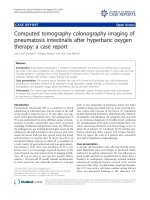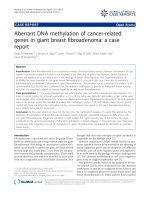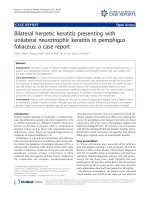Báo cáo y học: "Adrenal suppression due to an interaction between ritonavir and injected triamcinolone: a case report" docx
Bạn đang xem bản rút gọn của tài liệu. Xem và tải ngay bản đầy đủ của tài liệu tại đây (885.58 KB, 4 trang )
BioMed Central
Page 1 of 4
(page number not for citation purposes)
AIDS Research and Therapy
Open Access
Case report
Adrenal suppression due to an interaction between ritonavir and
injected triamcinolone: a case report
Kathryn Dort
1
, Shetal Padia
2
, Brian Wispelwey
1
and Christopher C Moore*
1
Address:
1
Department of Medicine, Division of Infectious Diseases and International Health, University of Virginia School of Medicine,
Charlottesville, Virginia, USA and
2
Department of Medicine, Division of Endocrinology, University of Virginia, School of Medicine,
Charlottesville, Virginia, USA
Email: Kathryn Dort - ; Shetal Padia - ; Brian Wispelwey - ;
Christopher C Moore* -
* Corresponding author
Abstract
Two HIV-1 infected patients developed signs and symptoms consistent with adrenal suppression
after being exposed to intra-articular triamcinolone acetate while also receiving ritonavir as part of
their highly active antiretroviral therapy. Laboratory evaluation confirmed secondary adrenal
suppression in both cases. Both patients recovered without the need for chronic replacement
steroids. Adrenal suppression has been described as an adverse outcome in patients treated with
fluticasone and concomitant ritonavir. In the reported cases, the adrenal suppression likely
developed as a result of increased systemic concentrations of triamcinolone due to an inhibition of
cytochrome p450 3A4 metabolism. Practitioners of HIV medicine should be aware of the potential
negative interaction of injected triamcinolone and ritonavir.
Introduction
Ritonavir reduces the metabolism of systemic steroids
including inhaled fluticasone which may lead to clinical
Cushing's syndrome and secondary adrenal insufficiency
[1-3]. Therefore, the decision to use inhaled or systemic
steroids in conjunction with ritonavir should be made
with caution. Despite occasional reports of Cushing's syn-
drome occurring with injected triamcinolone even in the
absence of cytochrome p450 3A4 inhibitors, it is not clear
that the same caution should be exercised when consider-
ing local steroid injections in the setting of ritonavir ther-
apy [4,5]. Here we present two cases of adrenal
suppression which occurred after intra-articular injections
of triamcinolone in HIV-1 infected persons receiving
ritonavir as part of their antiretroviral regimen.
Case report
Case 1
A 41 year-old HIV-1 infected man presented to our clinic
with concerns about non-healing abdominal bruising that
he related to a motor vehicle collision that occurred
approximately 6 weeks earlier. He noted weight gain with-
out a change in his appetite or food intake. He com-
plained of a pruritic rash on his upper chest and arms
which he had noticed for approximately one month. His
HIV-1 infection was treated daily with the fixed-dose com-
bination of 200 mg emtricitabine and 300 mg tenofovir as
well as 100 mg ritonavir and 300 mg atazanavir. He had
been on a ritonavir boosted protease inhibitor (PI) regi-
men for four years. His CD4+ T lymphocyte concentration
was 842/μL and his viral load was undetectable (level of
Published: 8 June 2009
AIDS Research and Therapy 2009, 6:10 doi:10.1186/1742-6405-6-10
Received: 10 November 2008
Accepted: 8 June 2009
This article is available from: />© 2009 Dort et al; licensee BioMed Central Ltd.
This is an Open Access article distributed under the terms of the Creative Commons Attribution License ( />),
which permits unrestricted use, distribution, and reproduction in any medium, provided the original work is properly cited.
AIDS Research and Therapy 2009, 6:10 />Page 2 of 4
(page number not for citation purposes)
detection <50 copies/mL-Roche v 1.5). He had been vac-
cinated against hepatitis A and B and uninfected by hepa-
titis C. He denied taking any inhaled or oral steroids, but
due to chronic low back pain he had received two transfo-
raminal epidural injections of 80 mg triamcinolone aceto-
nide at an outside facility approximately 3 and 2 months
prior to presentation.
His blood pressure was 144/88 mmHg and his pulse was
91 beats per minute which were elevated from his base-
line of approximately 100/75 mmHg and pulse of 80
beats per minute. His weight had increased by approxi-
mately 15 kg from his prior clinic visit 4 months prior. He
had notable truncal weight gain and new Cushingoid
facies. He had prominent 1 cm wide purple striae on the
anterior abdomen with scattered striae on the flanks bilat-
erally and acneiform lesions on the chest, shoulders, back
and upper arms (Figure 1).
A mid-morning cortisol concentration was 13.80 nmol/L
and his adrenocorticotropic hormone (ACTH) concentra-
tion was <0.22 pmol/L (normal range 1.98–11.44 pmol/
L). His thyroid-stimulating hormone concentration, elec-
trolytes and renal function were all within normal limits.
A synthetic glucocorticoid steroid blood screen revealed a
triamcinolone acetonide concentration of 98.9 mmol/L
(expected cutoff 6.9 mmol/L). He was counseled on the
symptoms of adrenal crisis but continued his antiretrovi-
ral regimen without steroid replacement.
One month after his initial presentation to clinic, his
symptoms had improved, he was normotensive, and his
weight was reduced by 4 kgs. Two months later due to
complaints of left hip pain an anterioposterior roentero-
gram of the pelvis and left hip was obtained and revealed
a large area of avascular necrosis within the left femoral
head with significant lateral cortical lucency. Four months
later, a mid-morning cortisol was 33.10 nmol/L, his
ACTH concentration was 1.32 pmol/L, CD4+T lym-
phocyte concentration was 693/μL and his viral load
remained undetectable. At his 6 month follow up visit, his
afternoon random cortisol and ACTH values had returned
to normal range (427.65 nmol/L and 5.72 pmol/L, respec-
tively).
Case 2
A 42-year-old HIV-1 infected woman presented to our
clinic with complaints of weight redistribution around the
neck and upper thighs, weakness, heat intolerance, blurry
vision, heart palpitations, fatigue, hyperexcitability,
insomnia, and increased appetite for approximately 20
days. Her HIV-1 infection was treated daily with the fixed
dose combination of 200 mg emtricitabine and 300 mg
tenofovir as well as daily 100 mg ritonavir and 300 mg
atazanavir. Her most recent CD4+ T lymphocyte concen-
tration was 693/μL and her viral load was undetectable.
She had been vaccinated against hepatitis A and B and was
not infected with hepatitis C.
Upon presentation to our clinic she was found to have a
blood pressure of 152/100 mmHg which was elevated
from her baseline of 100/58 mmHg. Thyroid function
studies, electrolytes and renal function were all within
normal limits. Further evaluation revealed a mid-morning
cortisol concentration of 55.18 nmol/L which increased
after 0.25 mg cosyntropin injection to 386.26 nmol/L at
60 minutes (normal response at 60 minutes is >469.03
nmol/L). Her morning ACTH concentration was < 0.22
pmol/L.
She denied using inhaled, oral or topical steroids. She had
not been prescribed medroxyprogesterone or megestrol
acetate. Due to a right shoulder impingement, she did
receive an injection of 40 mg triamcinolone acetonide in
her right subacromial space at an outside facility two
weeks prior to her symptom onset. Six months prior to
that she received a transforaminal epidural injection of
betamethasone acetate as treatment for cervical spondylo-
sis without complications while receiving the fixed-dose
combination of lamivudine and zidovudine plus efa-
virenz. Initially her adrenal suppression was treated with
a short burst of hydrocortisone (30 mg daily) to prevent
potential adrenal crisis but this was discontinued after
three days. Two months later the patient was asympto-
matic and her random afternoon cortisol was 110.36
nmol/L, ACTH 1.76 pmol/L, CD4+ T lymphocytes 444/
μLand viral load remained undetectable.
Discussion
Cushing's syndrome is known to occur with high doses of
exogenous steroids, but has rarely been associated with
triamcinolone injections [4-6]. Our patients' symptoms
occurred approximately two weeks after intra-articular
injection of triamcinolone acetonide while they were also
receiving the fixed-dose combination of emtricitabine and
tenofovir plus ritonavir and atazanavir. They had no his-
tory of concomitant inhaled, intranasal or topical ster-
oids. Therefore, their adrenal suppression likely
represents a drug interaction between ritonavir, a known
inhibitor of steroid metabolism, and intra-articular injec-
tion with triamcinolone acetonide.
The ability of ritonavir to inhibit cytochrome P450 3A4
(CYP 3A4) is exploited to increase the bioavailbility of
other PIs and increase their dosing intervals [7,8]. How-
ever, ritonavir increases the concentration of exogenous
steroids through the same mechanism. One pharmacoki-
netic study revealed a 28% increase in prednisolone expo-
sure when ritonavir was co-administered with oral
prednisolone, the active metabolite of triamcinolone.
AIDS Research and Therapy 2009, 6:10 />Page 3 of 4
(page number not for citation purposes)
This was thought to occur due to the inhibition of the CYP
3A4 system, the primary method of metabolism of pred-
nisolone [3]. Prednisolone is also known to have an
increased area under the plasma concentration versus
time curve and decreased oral clearance when combined
with ritonavir [9]. These findings are similar to the inter-
action of other CYP3A4 inhibitors, e.g. itraconazole, with
prednisolone. This rapid, increased exposure to exoge-
nous glucocorticoids may lead to clinical Cushing's syn-
drome and suppression of the hypothalamic-pituitary-
adrenal (HPA) axis which may last from nine months to a
year [10,11].
In a pharmacokinetic study of intra-articular administra-
tion of triamcinolone acetonide endogenous hydrocorti-
sone suppression correlated with exogenous steroid
concentrations and triamcinolone was fully absorbed
within two to three weeks[12]. Therefore, when our
patients presented to our clinic several weeks after their
intra-articular injections we would not have expected
them to have such profound HPA axis suppression from
triamcinolone alone, or in case 2 from a betamethasone
injection 6 months prior. On the contrary, our cases cor-
roborate the concern raised by two other recently pub-
lished reports of adrenal insufficiency following
administration of intra-articular injections of triamci-
nolone acetonide 40 mg in patients infected with HIV-1
receiving a ritonavir boosted PI regimen [13,14].
Once iatrogenic adrenal suppression is suspected, a ran-
dom, preferably morning, serum cortisol and ACTH
should be obtained. An ACTH (cosyntropin) stimulation
test can confirm adrenal axis suppression caused by exog-
enous glucocorticoids. In Case 1, the synthetic glucocorti-
coid steroid screen confirmed that the prior triamcinolone
acetonide injection was the source of exogenous steroids
and presumably adrenal suppression. Usually careful his-
tory taking will provide the source of exogenous steroids,
but this screening test may be useful in cases where history
is lacking but clinical suspicion is high.
In cases of adrenal suppression due to exogenous gluco-
corticoid administration, physiological replacement with
hydrocortisone may not be necessary and chronic use of
supraphysiological doses of corticosteroids should be
avoided [11]. Corticosteroids, usually hydrocortisone,
may be necessary in the acute setting of adrenal insuffi-
ciency which can be apparent at diagnosis and with sub-
sequent periods of stress (e.g. trauma, surgery or severe
illness) [11]. Additionally, when further steroids are
required it may be necessary to substitute non-nucleoside
reverse transcriptase inhibitors or newer agents such as
integrase inhibitors or CCR5 inhibitors for ritonavir
boosted PIs. It is also important to avoid other CYP 3A4
inhibitory drugs such as itraconazole which may also
increase the concentration of circulating corticosteroids.
Avoidance of chronic corticosteroid replacement in both
of these patients likely allowed speedier recovery of their
HPA axes without the need to switch from their ritonavir
boosted PI regimens from which they both had good viro-
logic response.
A high index of suspicion for adrenal suppression is
required when considering protean symptoms of a riton-
avir treated HIV-1 infected patient who has recently
received corticosteroids. As with our patients, careful his-
tory taking and physical examination are required to
make the diagnosis and reveal the source of glucocorti-
coid exposure. The diagnosis may be obscured by a prior
history of lipodystrophy which has similar clinical find-
ings to those of Cushing's syndrome. However, a diagno-
sis is crucial to avoid the myriad complications of adrenal
suppression and excess exogenous glucocorticoids which
may include neuropsychological changes, hypertension,
diabetes, osteoporosis and necrosis, and immune defi-
ciency, among others.
Patient 1 with stigmata of Cushing's syndrome including acneiform rash, truncal obesity, and abdominal striaeFigure 1
Patient 1 with stigmata of Cushing's syndrome
including acneiform rash, truncal obesity, and
abdominal striae.
Publish with BioMed Central and every
scientist can read your work free of charge
"BioMed Central will be the most significant development for
disseminating the results of biomedical research in our lifetime."
Sir Paul Nurse, Cancer Research UK
Your research papers will be:
available free of charge to the entire biomedical community
peer reviewed and published immediately upon acceptance
cited in PubMed and archived on PubMed Central
yours — you keep the copyright
Submit your manuscript here:
/>BioMedcentral
AIDS Research and Therapy 2009, 6:10 />Page 4 of 4
(page number not for citation purposes)
Conclusion
As the HIV-1 infected population with access to antiretro-
viral therapy ages they are likely to encounter diseases
with a predilection for the elderly such as degenerative
joint disease and osteoarthritis. Due to the frequent use of
ritonavir in antiretroviral regimens and the common prac-
tice of intra-articular injection of steroids for rheumatic
diseases, more research is needed to evaluate the interac-
tion of injected steroids and ritonavir We advocate that
any use of steroid supplementation, including intra-artic-
ular injection, should be used with caution in the setting
of concurrent use of ritonavir.
Consent
Written informed consent was obtained from the patients
for publication of their case report and the accompanying
image. A copy of the written consent is available for
review by the Editor-in-Chief of this journal.
Competing interests
The authors declare that they have no competing interests.
Authors' contributions
All authors participated in the drafting of the manuscript.
All authors read and approved the final manuscript.
Acknowledgements
None
References
1. St Germain RM, Yigit S, Wells L, Girotto JE, Salazar JC: Cushing syn-
drome and severe adrenal suppression caused by fluticasone
and protease inhibitor combination in an HIV-infected ado-
lescent. AIDS Patient Care STDS 2007, 21:373-7.
2. Foisy MM, Yakiwchuk EM, Chiu I, Singh AE: Adrenal suppression
and Cushing's syndrome secondary to an interaction
between ritonavir and fluticasone: a review of the literature.
HIV Med 2008, 9:389-96.
3. Busse KH, Formentini E, Alfaro RM, Kovacs JA, Penzak SR: Influence
of antiretroviral drugs on the pharmacokinetics of pred-
nisolone in HIV-infected individuals. J Acquir Immune Defic Syndr
2008, 48:561-6.
4. Gondwe JS, Davidson JE, Deeley S, Sills J, Cleary AG: Secondary
Cushing's syndrome in children with juvenile idiopathic
arthritis following intra-articular triamcinolone acetonide
administration. Rheumatology (Oxford) 2005, 44:1457-8.
5. Kumar S, Singh RJ, Reed AM, Lteif AN: Cushing's syndrome after
intra-articular and intradermal administration of triamci-
nolone acetonide in three pediatric patients. Pediatrics 2004,
113:1820-4.
6. Horani MH, Silverberg AB: Secondary Cushing's syndrome after
a single epidural injection of a corticosteroid. Endocr Pract
2005, 11:408-10.
7. Boyle BA, Elion RA, Moyle GJ, Cohen CJ: Considerations in select-
ing protease inhibitor therapy. AIDS Rev 2004, 6:218-25.
8. Gallant JE: Protease-inhibitor boosting in the treatment-expe-
rienced patient. AIDS Rev 2004, 6:226-33.
9. Penzak SR, Formentini E, Alfaro RM, Long M, Natarajan V, Kovacs J:
Prednisolone pharmacokinetics in the presence and absence
of ritonavir after oral prednisone administration to healthy
volunteers. J Acquir Immune Defic Syndr 2005, 40:573-80.
10. Woods DR, Arun CS, Corris PA, Perros P: Cushing's syndrome
without excess cortisol. Bmj 2006, 332:469-70.
11. Hopkins RL, Leinung MC: Exogenous Cushing's syndrome and
glucocorticoid withdrawal. Endocrinol Metab Clin North Am 2005,
34:371-84.
12. Derendorf H, Mollmann H, Gruner A, Haack D, Gyselby G: Pharma-
cokinetics and pharmacodynamics of glucocorticoid suspen-
sions after intra-articular administration. Clin Pharmacol Ther
1986, 39:313-7.
13. Ramanathan R, Pau AK, Busse KH, Zemskova M, Nieman L, Kwan R,
Hammer JH, Mican JM, Maldarelli F: Iatrogenic Cushing syndrome
after epidural triamcinolone injections in an HIV type 1-
infected patient receiving therapy with ritonavir-lopinavir.
Clin Infect Dis 2008, 47:e97-9.
14. Yombi JC, Maiter D, Belkhir L, Nzeusseu A, Vandercam B: Iatro-
genic Cushing's syndrome and secondary adrenal insuffi-
ciency after a single intra-articular administration of
triamcinolone acetonide in HIV-infected patients treated
with ritonavir. Clin Rheumatol 2008, 27(Suppl 2):S79-82.









